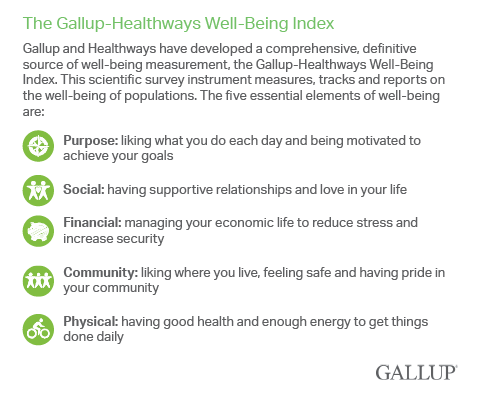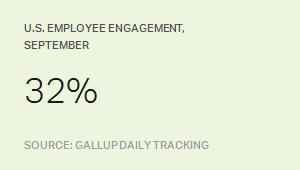Story Highlights
- Engagement and well-being are keys to employee performance
- Just 32% of U.S. workers are engaged in their jobs
- Leaders can make a substantial difference in employee well-being
Two major factors influence employee performance, Gallup has found: engagement and well-being. Gallup measures engagement for employees through the Q12 survey, which consists of 12 actionable items with proven links to performance outcomes. And with Healthways, we measure well-being through five elements that are crucial to a life well-lived.
Now, many organizations measure and evaluate their employees' engagement, while others focus on improving their workers' well-being. But what happens when companies try to improve both? Does strong well-being take a highly engaged workforce and make it even better? And how can each one be applied to enhance the other?
Defining Engagement and Well-Being
Based on employees' responses to the Q12 items, Gallup groups workers into one of three categories: engaged, not engaged or actively disengaged. Just 32% of U.S. workers are engaged in their jobs, setting them apart from other workers in terms of their attendance, performance, service quality, safety and likelihood to stay with their current company, among other factors.
Similarly, Gallup and Healthways have developed a comprehensive, research-based definition of well-being that encompasses five interrelated and essential elements: purpose, social, financial, community and physical. Together, these elements provide key insights into individuals' sense of purpose, social relationships, financial security, relationship to their community and physical health.

Respondents can be classified as thriving, struggling and suffering in each element according to how they rate that particular facet of well-being in their lives:
- Thriving: well-being that is strong, consistent and progressing in a particular element
- Struggling: well-being that is moderate or inconsistent in a particular element
- Suffering: well-being that is low and at high risk in a particular element
In the U.S., 28% of adults aged 18 and older are not thriving in any element, while just 19% are thriving in at least four of the five. For every two U.S. adults who are exhibiting high levels of well-being across most or all elements, there are three who have significant room for improvement across them all.
The Benefits of Adding High Well-Being to High Engagement
The question researchers have explored is: How do employees who are engaged and who exhibit high well-being in at least four of the five elements fare compared with engaged workers who have high well-being in only three or fewer elements? Does adding high well-being to high engagement have a beneficial effect on key outcomes?
Compared with employees who have high engagement but otherwise exhibit low levels of well-being, those who are engaged and who have high well-being in at least four of the five elements are 30% more likely not to miss any workdays because of poor health in any given month. They also miss 70% fewer workdays because of poor health over the course of a year. In addition, employees who are engaged and have high well-being are:
- 42% more likely to evaluate their overall lives highly
- 27% more likely to report "excellent" performance in their own job at work
- 27% more likely to report "excellent" performance by their organization
- 45% more likely to report high levels of adaptability in the presence of change
- 37% more likely to report always recovering "fully" after illness, injury or hardship
- 59% less likely to look for a job with a different organization in the next 12 months
- 18% less likely to change employers in a 12-month period
- 19% more likely to volunteer their time in the past month
How Leaders Can Add Well-Being to Their Engagement Programs
Leaders can make a substantial difference in their employees' lives by including well-being principles in their company's engagement programs, thus effecting change in both areas at the same time. These five strategies can be deployed right now to increase employee engagement and well-being:
- Strongly encourage participation in well-being activities when setting job expectations. Let employees choose the well-being activities that are best suited to them based on their individual well-being goals. This approach simultaneously promotes clarity about an employee's role and a culture of well-being, and it does both while honoring each employee's unique talents and interests.
- Recognize employees for their well-being achievements. Recognition reinforces what is valued within an organizational culture. One reason recognition is such a strong driver of employee engagement is that if employees feel they will be recognized for doing great work, they will be highly motivated to do so. The same principle applies to enhancing well-being. Increase recognition to increase effort -- and improve well-being and engagement at the same time.
- Explicitly link each well-being activity to at least one of the five elements. The five elements of well-being add depth and dimension to "feeling cared about," a key component of engagement. The five elements can help managers more clearly individualize activities to each employee's situation through discussion and by creating a more focused set of goals. Leaders and managers should communicate that the five elements are important organizational values and show how each well-being program links to one or more of the elements. Communication that emphasizes that leadership cares about employees' -- and their families' -- well-being can go a long way in encouraging employee engagement and employee participation in well-being programs.
- Solicit employee ideas and incorporate them into workplace well-being initiatives. "Opinions count" is a central component of an engaging workplace. Asking employees to contribute well-being ideas is a great way to galvanize them and make them feel they are a part of the well-being movement. Employees also will have excellent feedback about which well-being programs are working and which aren't -- and how they can be revised or new programs added.
- Include well-being goal-setting and milestones in work review and progress meetings. Research has shown that engaged employees are much more comfortable than other employees in discussing their well-being goals with their manager. But the five well-being elements can be incorporated into progress-review conversations in ways that encourage employees to pursue their well-being goals and that can deepen the manager-employee relationship. One way to start this conversation is for a manager to ask, "Is there an aspect of your well-being that I can support?"
Ultimately, organizations can benefit substantially by adding well-being to their engagement programs. By ignoring well-being, or by focusing on physical wellness programs alone, employers miss important opportunities to improve employee performance.
Survey Methods
Results are based on a Gallup Panel Web study completed by 24,230 national adults, aged 18 and older, conducted Oct. 8-Nov. 13, 2014, and a Gallup Panel Web study completed by 24,658 national adults, aged 18 and older, conducted Dec. 2, 2014-Jan. 14, 2015. A subsample of 9,689 working adults, obtained after matching the above two surveys, was used for this analysis. The Gallup Panel is a probability-based longitudinal panel of U.S. adults who are selected using random-digit-dial (RDD) phone interviews that cover landline and cellphones. Address-based sampling methods are also used to recruit panel members. The Gallup Panel is not an opt-in panel, and members are not given incentives for participating. The sample for this study was weighted to be demographically representative of the U.S. adult population using 2014 Current Population Survey figures. For results based on this sample, one can say that the maximum margin of sampling error is ±2 percentage points at the 95% confidence level. Margins of error are higher for subsamples. In addition to sampling error, question wording and practical difficulties in conducting surveys can introduce error and bias into the findings of public opinion polls.
Jim Harter contributed to the content of this article.



